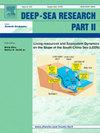Live and dead zooplankton distributions within the Humboldt current system during upwelling and downwelling events
IF 3
3区 地球科学
Q2 OCEANOGRAPHY
Deep-sea Research Part Ii-topical Studies in Oceanography
Pub Date : 2025-08-14
DOI:10.1016/j.dsr2.2025.105530
引用次数: 0
Abstract
Traditional field sampling assumes all zooplankton collected are originally alive, but ignoring even a small percentage of dead zooplankton can result in large errors in predicting population dynamics and secondary production. We tested a protocol for Neutral Red staining and live/dead sorting of zooplankton samples from upwelling zones within the Humboldt Current System. In laboratory tests, live individuals of diverse copepod species including eggs, naupliar and advanced stages, as well as several gelatinous zooplankton groups, were stained readily and the staining efficiency was better than 94.6 %. Larval fish and crabs were only weakly stained. Once validated, we applied the staining method in field sampling in Mejillones Bay and Concepcion during upwelling and downwelling periods. Both abundances and percentages of zooplankton carcasses were significantly higher during upwelling events, and carcasses were mostly concentrated within the Oxygen Minimum Zone, suggesting that intrusion of oxygen-poor water during upwelling led to higher non-predatory mortality especially among species sensitive to hypoxia. Carcass abundances also varied between developmental stages, likely a result of differences in low-oxygen tolerance as well as in situ abundances between stages. Incorporation of Neutral Red staining method into routine sampling will generate live/dead zooplankton distribution data that will improve understanding of zooplankton population dynamics, secondary production, trophic link to fisheries, and zooplankton responses to environmental changes.
洪堡洋流系统在上升流和下升流期间的活的和死的浮游动物分布
传统的野外取样假设收集到的所有浮游动物最初都是活的,但即使忽略一小部分死亡的浮游动物,也会导致预测种群动态和次生产量的巨大误差。我们对来自洪堡洋流系统内上升流区浮游动物样本的中性红染色和活/死分类方案进行了测试。在实验室试验中,对包括卵、无足动物和晚期在内的多种桡足动物的活个体以及几种凝胶状浮游动物群体进行了染色,染色效率优于94.6%。幼鱼和蟹只被轻微染色。经过验证后,我们将染色方法应用于Mejillones Bay和Concepcion的上升流和下升流期间的现场采样。在上升流期间,浮游动物的尸体丰度和百分比都显著高于其他时期,并且尸体主要集中在氧气最小带内,这表明上升流期间贫氧水的入侵导致了更高的非掠食性死亡率,特别是对缺氧敏感的物种。胴体丰度在不同的发育阶段也有所不同,可能是由于不同阶段的低氧耐受性和原位丰度的差异。将中性红染色法纳入常规采样将产生活/死浮游动物分布数据,这将有助于了解浮游动物种群动态、次生生产、与渔业的营养联系以及浮游动物对环境变化的反应。
本文章由计算机程序翻译,如有差异,请以英文原文为准。
求助全文
约1分钟内获得全文
求助全文
来源期刊
CiteScore
6.40
自引率
16.70%
发文量
115
审稿时长
3 months
期刊介绍:
Deep-Sea Research Part II: Topical Studies in Oceanography publishes topical issues from the many international and interdisciplinary projects which are undertaken in oceanography. Besides these special issues from projects, the journal publishes collections of papers presented at conferences. The special issues regularly have electronic annexes of non-text material (numerical data, images, images, video, etc.) which are published with the special issues in ScienceDirect. Deep-Sea Research Part II was split off as a separate journal devoted to topical issues in 1993. Its companion journal Deep-Sea Research Part I: Oceanographic Research Papers, publishes the regular research papers in this area.

 求助内容:
求助内容: 应助结果提醒方式:
应助结果提醒方式:


